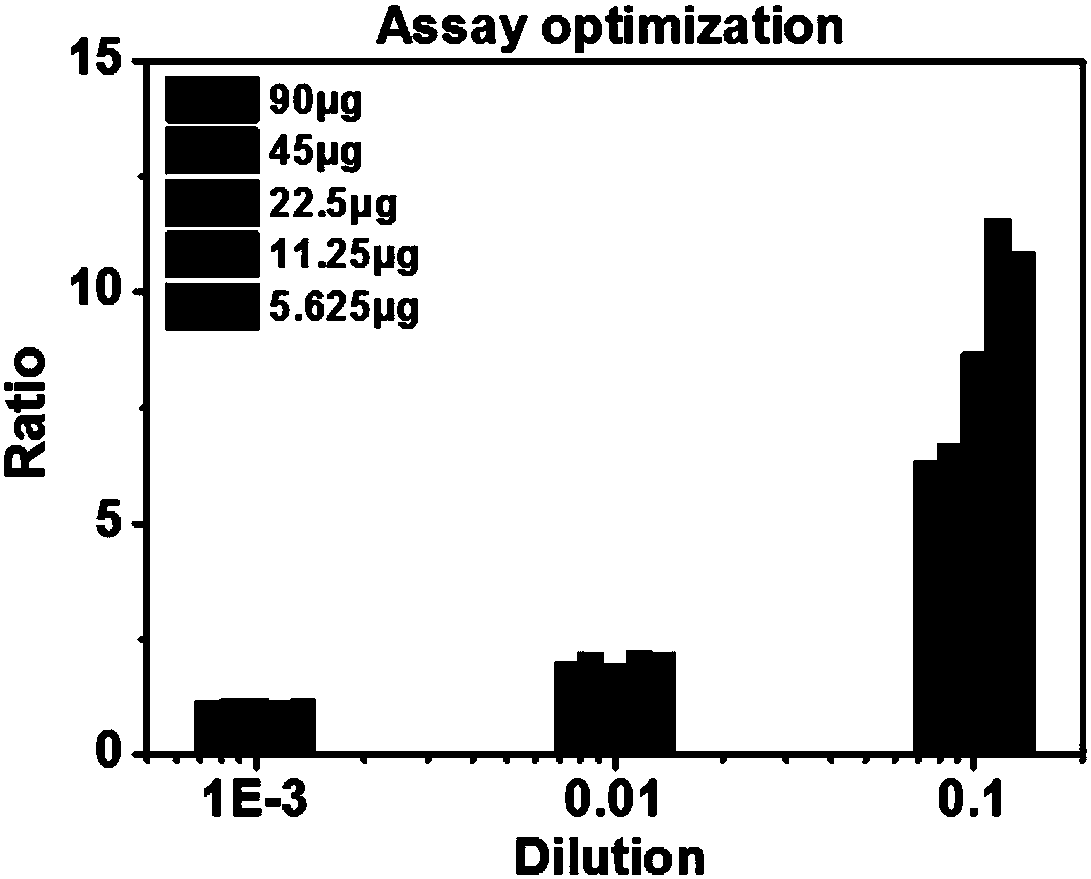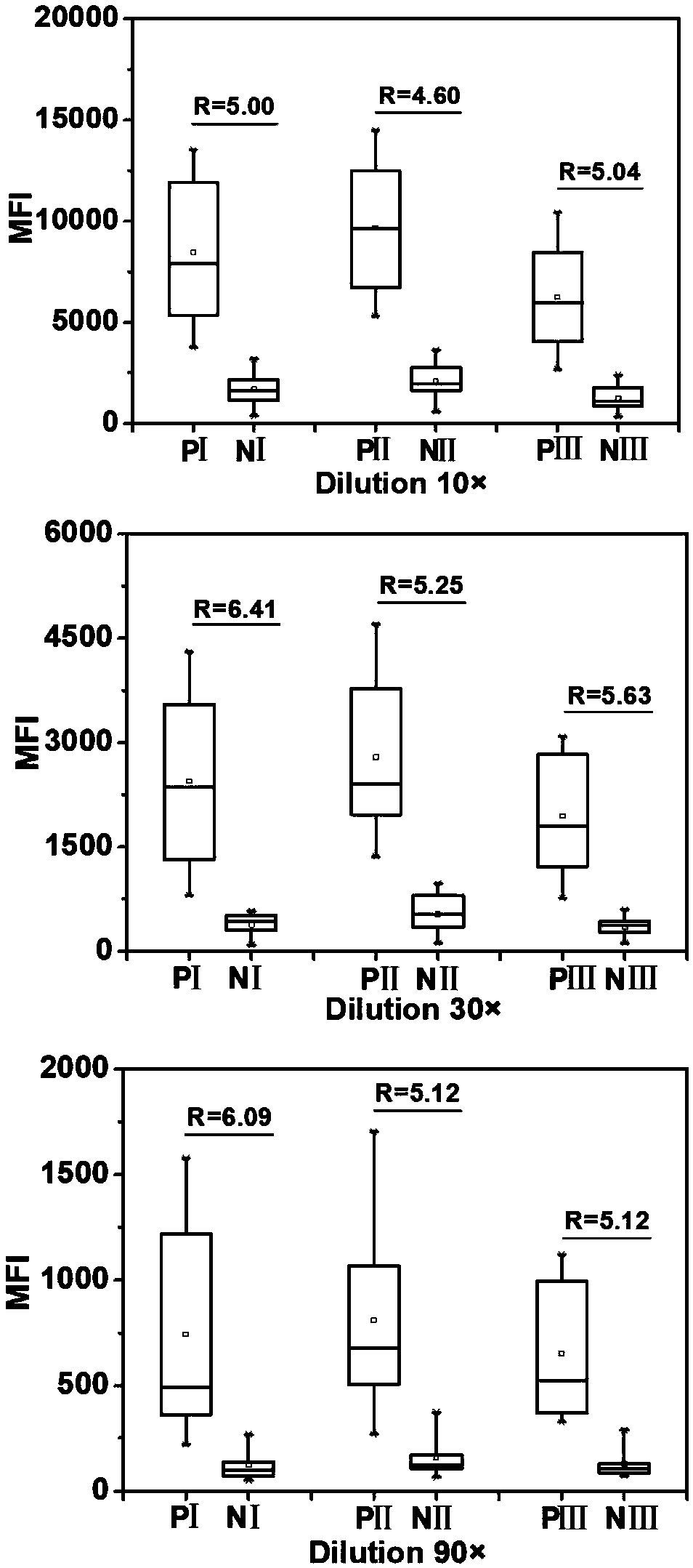Blood group antigen chip and application thereof in detection of unexpected erythrocyte antibodies
A technology of erythrocytes and erythrocyte membranes, which is applied in the field of biomedicine, can solve the problems of poor sensitivity of erythrocyte accidental antibodies, low throughput screening ability, and narrow dynamic linear range, so as to avoid complex operation steps, wide linear range, and high sensitivity. Effect
- Summary
- Abstract
- Description
- Claims
- Application Information
AI Technical Summary
Problems solved by technology
Method used
Image
Examples
Embodiment 1
[0059] Example 1 Effect of Microsphere Coupling Conditions on Detection of Unexpected Antibodies in Erythrocytes
[0060] Select three kinds of uncoupled microspheres and resuspend them by ultrasonication for 2 minutes, take 50 μl concentration of 2.5×10 6microspheres / ml into the EP tube, place the EP tube on the magnetic plate for 60 seconds, and remove the supernatant; remove the magnetic separator and resuspend the microspheres with 100 microliters of deionized water, and place the EP tube on the magnetic plate Plate for 60 seconds, remove the supernatant; remove the magnetic separator and use 80 microliters of 100mM, pH6.2 disodium hydrogen phosphate buffer, shake to resuspend the microspheres, add 10 microliters of 50mg / ml Sulfo-NHS solution (dissolved in water), gently shake and mix, add 10 microliters of 50mg / ml EDC solution (dissolved in water), gently shake and mix, incubate at room temperature for 20 minutes, gently shake and mix once every 10 minutes; Place the EP ...
Embodiment 2
[0062] Example 2 The influence of the dilution factor of the detection sample on the detection of unexpected antibodies in red blood cells
[0063] Get 10 examples of positive specimens (detected by the microcolumn gel method) and 10 examples of negative specimens (detected by the microcolumn gel method), and carry out 10-fold, 30-fold and 90-fold dilutions of the 20 specimens respectively and prepare them in Example 1 The coupled microspheres were reacted, and the specific steps were: take a 96-well plate, add 200 microliters of PBS-TBN solution to each well and incubate at 37°C for 1 hour to block. Add 50 microliters of antibodies with different dilution factors and 2500 coupled microspheres, make up the volume of the system to 100 microliters for reaction; centrifuge the microplate at 2000rpm for 2 minutes, then place the 96-well plate on the magnetic plate for 2 minutes, Remove the supernatant; wash the 96-well plate twice with 100 microliters of PBS-TBN solution; add 50 m...
Embodiment 3 2
[0065] Example 3 The impact of the added concentration of the secondary antibody on the detection of unexpected antibodies in erythrocytes
[0066] Get 10 cases each of positive samples (detected by microcolumn gel method) and negative samples (detected by microcolumn gel method), and react with the coupled microspheres prepared in Example 1, wherein 8ug / ml of Cy3-labeled anti-human IgG and 2ug / ml Cy3-labeled anti-human IgG were used as secondary antibodies. The specific steps included: taking a 96-well plate, adding 200 microliters of PBS-TBN solution to each well and incubating at 37°C for 1 hour to block. Add 50 microliters of antibody with the same dilution factor and 2500 coupled microspheres, make up the volume of the system to 100 microliters for reaction; centrifuge the microplate at 2000rpm for 2 minutes, then place the 96-well plate on the magnetic plate for 2 minutes, Remove the supernatant; wash the 96-well plate twice with 100 microliters of PBS-TBN solution; add ...
PUM
 Login to View More
Login to View More Abstract
Description
Claims
Application Information
 Login to View More
Login to View More - R&D
- Intellectual Property
- Life Sciences
- Materials
- Tech Scout
- Unparalleled Data Quality
- Higher Quality Content
- 60% Fewer Hallucinations
Browse by: Latest US Patents, China's latest patents, Technical Efficacy Thesaurus, Application Domain, Technology Topic, Popular Technical Reports.
© 2025 PatSnap. All rights reserved.Legal|Privacy policy|Modern Slavery Act Transparency Statement|Sitemap|About US| Contact US: help@patsnap.com



